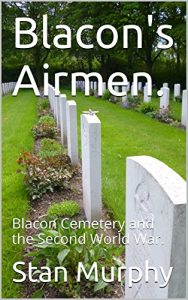Blacon Cemetery and the Second World War.
This was a new cemetery in 1940, enabling the authorities to set aside two large areas for the burial of service casualties, and almost 561 war graves in the cemetery are in one or other of these plots. The larger plot (A) was designed as one of the five Royal Air force cemeteries in June-July 1943 and close to 400 men and women of the air services were laid to rest here, more tha 300 far from their homes in Canada, Australia and the rest of the Empire.
The smaller plot (H) is the final resting place of 51 men and women of the British army, including two members of the African Pioneer Corps, along with four Russian soldiers and six Italian and German prisoners of war. The graves of more than 100 members of the Polish Army and Polish Resettlement Corps, most of whom died in 1947, can be found in Plot H.
Many thousands of Polish sevicemen and refugees did not wish to return to their homeland under the post war communist rule, and the Resettlement Corps was created to assist troops in the transition to civilian life in the UK. There were several resettlement camps between Chester, Northwich and Nantwich and those who died in the camps or hospitals were interred here.
The intensified Allied air offensive from the British Isles prompted the preparation of RAF Regional Cemeteries, and the Dominions decided these would be used for all the airmen from mid-1943. Many of the airmen commemorated here died in crashes caused by poor weather on training exercises or operational flights, or through enemy actions over British territory. They represent the many kinds of service within the air forces of the Second World war: nighterfighter squadrons protecting British cities, Coastal Command planes patrolling for U-boats, Pathfinder crews who marked targets in occupied Europe for the 'heavies' of Bomber Command, meteorological and reconnaissance work, and the ground staff who supported it all. The variety of nationalities present underlies the support and sacrifice of the Commonwealth and Allies during the Second World war. After the war, the Ontario Horticultural Association sent Maple trees to be planted by the Commission in Blacon Cemetery to mark the presence of more than 190 Canadian Airmen, the largest Commonwealth contingent in the cemetery.
Though only charged with responsibility for the graves of those killed in the two world wars, under some circumstances, on behalf of the Ministry of Defence, the Commission cares for those who fell in other conflicts. Three of these servicemen have ben laid to rest here, including a young infantryman from Chester killed in action in Helmand in 2010, laid to rest in Plot H.
This was a new cemetery in 1940, enabling the authorities to set aside two large areas for the burial of service casualties, and almost 561 war graves in the cemetery are in one or other of these plots. The larger plot (A) was designed as one of the five Royal Air force cemeteries in June-July 1943 and close to 400 men and women of the air services were laid to rest here, more tha 300 far from their homes in Canada, Australia and the rest of the Empire.
The smaller plot (H) is the final resting place of 51 men and women of the British army, including two members of the African Pioneer Corps, along with four Russian soldiers and six Italian and German prisoners of war. The graves of more than 100 members of the Polish Army and Polish Resettlement Corps, most of whom died in 1947, can be found in Plot H.
Many thousands of Polish sevicemen and refugees did not wish to return to their homeland under the post war communist rule, and the Resettlement Corps was created to assist troops in the transition to civilian life in the UK. There were several resettlement camps between Chester, Northwich and Nantwich and those who died in the camps or hospitals were interred here.
The intensified Allied air offensive from the British Isles prompted the preparation of RAF Regional Cemeteries, and the Dominions decided these would be used for all the airmen from mid-1943. Many of the airmen commemorated here died in crashes caused by poor weather on training exercises or operational flights, or through enemy actions over British territory. They represent the many kinds of service within the air forces of the Second World war: nighterfighter squadrons protecting British cities, Coastal Command planes patrolling for U-boats, Pathfinder crews who marked targets in occupied Europe for the 'heavies' of Bomber Command, meteorological and reconnaissance work, and the ground staff who supported it all. The variety of nationalities present underlies the support and sacrifice of the Commonwealth and Allies during the Second World war. After the war, the Ontario Horticultural Association sent Maple trees to be planted by the Commission in Blacon Cemetery to mark the presence of more than 190 Canadian Airmen, the largest Commonwealth contingent in the cemetery.
Though only charged with responsibility for the graves of those killed in the two world wars, under some circumstances, on behalf of the Ministry of Defence, the Commission cares for those who fell in other conflicts. Three of these servicemen have ben laid to rest here, including a young infantryman from Chester killed in action in Helmand in 2010, laid to rest in Plot H.






